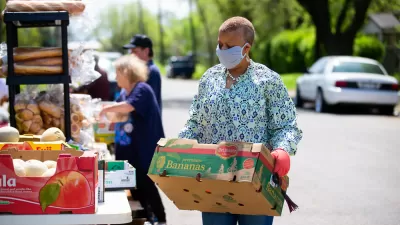A recent video claimed that high income inequality is the “Thing That Will Destroy Our Cities.” Is this true?

One of my favorite YouTube channels, CityNerd, recently ran a video with the impressively clickbaity title, “This Is the Thing That Will Destroy Our Cities.” The video made it clear that the “thing” in question is the Gini coefficient, a measurement of income inequality. The video vaguely suggested that income inequality has something to do with “social discontent and political polarization.” The video stated that “If you set up a system designed to accumulate wealth to people who already have it you’d better plan on paying more for police to keep the rabble in line.”
The video listed the metropolitan areas with the highest and lowest Gini coefficients. The ten highest-inequality metros include Cleveland, San Jose, Tampa, Birmingham, New Orleans, Boston, San Francisco, Los Angeles, Miami, and New York. The lowest-inequality metros include Washington, D.C., Grand Rapids, Raleigh, Riverside/San Bernardino, and Salt Lake City. Are the high-inequality metros more “destroyed” than the others?
Contrary to CityNerd’s speculations about social order, the correlation between inequality and crime is weak. Both groups included high-crime central cities and low-crime central cities. The poorer cities in the high-inequality group do have sky-high violence. Birmingham had 75 murders per 100,000 residents in 2023,* New Orleans had 51, and Cleveland had 44. On the other hand, Miami had between 6 and 7 homicides per 100,000 residents (roughly the national murder rate), New York and Boston had between 4 and 5, and San Jose had only 3.7. San Francisco had only 6.1 murders per 100,000 people (although nearby Oakland had four times that many). Los Angeles and Tampa were between the extremes discussed above, with 8.5 and 9.5 homicides respectively per 100,000 residents.
What about the low-inequality cities? Washington had a dreadful 38 homicides per 100,000, and San Berardino had an also not-great 16.** Grand Rapids had 12 homicides per 100,000 residents, about the same as Tampa. Raleigh had only 6 homicides per 100,000 residents, and Salt Lake City had about 7.5.
Although the mean of the high-inequality cities (21, or 24 if you count Oakland instead of San Francisco) is higher than the mean for the low-inequality cities (15), the median for the high-inequality cities is lower: only three of the ten high-inequality cities had over 10 homicides per 100,000 residents, as opposed to a majority of the low-inequality cities. In short, there doesn’t seem to be a strong correlation between regional inequality and social disorder.
CityNerd also mentions car dependency and housing affordability as problems somehow related to inequality (0:58). However, some of the most unequal cities, like Boston and New York, are among the least car-dependent in the U.S., and some (like Birmingham and Cleveland) are even relatively affordable.
Having said that, one might argue that because rich people are likely to bid up housing prices and less affluent households are likely to move to car-dependent suburbs to escape high housing costs, the costs of housing and transportation are greater in more unequal metros. To measure housing and transportation costs, I used fact sheets from the Center for Neighborhood Technology; I defined transportation costs for each metro area as the average yearly transportation cost calculated by CNT, and housing costs as average yearly housing costs (that is, the average monthly cost calculated by CNT times 12).
By this measure, the most expensive metros were among the most unequal. San Francisco, one of the most unequal metros, had the highest combined housing and transportation costs (almost $45,000 per year). Five other top-ten metros had housing/transportation costs over $35,000: San Jose (39.8k), Boston and Los Angeles (both hovering around 39.5k), and New York (36.4k).
However, the least unequal metros were only slightly cheaper. Washington’s combined housing and transportation costs were $40,515 per household, and Riverside/San Bernardino costs its average household $36,914 for transportation/housing.
Moreover, the cheapest high-inequality metros were cheaper than the cheapest low-inequality metros. The cheapest low-inequality metro was Grand Rapids, where housing and transportation cost the average household $29,559- more than in Cleveland ($27.7k), Tampa ($29.3k), Birmingham ($28.1k) and New Orleans ($28.9k). So if you measure housing and transportation costs in raw dollars, there isn’t a particularly strong correlation between inequality and high costs; the most costly metros were very unequal, but so were the least costly metros.***
Having said that, I did find one area where high-inequality metros performed poorly: population growth. Most of the high-inequality metros grew by less than 10 percent during the 2010s; the only exceptions were Tampa (where the population grew by about 16 percent) and Cleveland (which lost population). By contrast, all five of the low-inequality metros grew by over 10 percent. Census estimates show that between 2020 and 2022, all but one (Tampa) of the high-inequality metros lost population according to Census estimates, while most of the low-inequality metros gained population. However, it is not altogether clear to me how high income inequality would lead to population loss; it seems to me more likely that the high housing costs of the more affluent high-inequality metros (such as New York and Boston) are what limit population growth.
*I used data from americanviolence.org for most cities, but used data from Google searches where such data was unavailable. I focused on homicides in central cities rather than metro-wide data or other crimes because the former data is the most easily available, and also because only the poorest suburbs have crime levels comparable to those of most central cities discussed above.
**I was unable to find 2023 data for Riverside, so I used data from San Bernardino.
***Just to add an additional layer of complexity: if you define costs by looking at costs as a percentage of household income, the high-cost metros look a lot cheaper while low-wage metros like Cleveland look a lot more expensive. But I chose not to focus on this method because the high costs of metros like San Francisco, by pricing out middle- and lower-class households, artificially raise metro household incomes and thus lower housing costs as a percentage of household income.

Trump Administration Could Effectively End Housing Voucher Program
Federal officials are eyeing major cuts to the Section 8 program that helps millions of low-income households pay rent.

Planetizen Federal Action Tracker
A weekly monitor of how Trump’s orders and actions are impacting planners and planning in America.

Ken Jennings Launches Transit Web Series
The Jeopardy champ wants you to ride public transit.

California Invests Additional $5M in Electric School Buses
The state wants to electrify all of its school bus fleets by 2035.

Austin Launches $2M Homelessness Prevention Fund
A new grant program from the city’s Homeless Strategy Office will fund rental assistance and supportive services.

Alabama School Forestry Initiative Brings Trees to Schoolyards
Trees can improve physical and mental health for students and commnity members.
Urban Design for Planners 1: Software Tools
This six-course series explores essential urban design concepts using open source software and equips planners with the tools they need to participate fully in the urban design process.
Planning for Universal Design
Learn the tools for implementing Universal Design in planning regulations.
Ada County Highway District
Clanton & Associates, Inc.
Jessamine County Fiscal Court
Institute for Housing and Urban Development Studies (IHS)
City of Grandview
Harvard GSD Executive Education
Toledo-Lucas County Plan Commissions
Salt Lake City
NYU Wagner Graduate School of Public Service






























